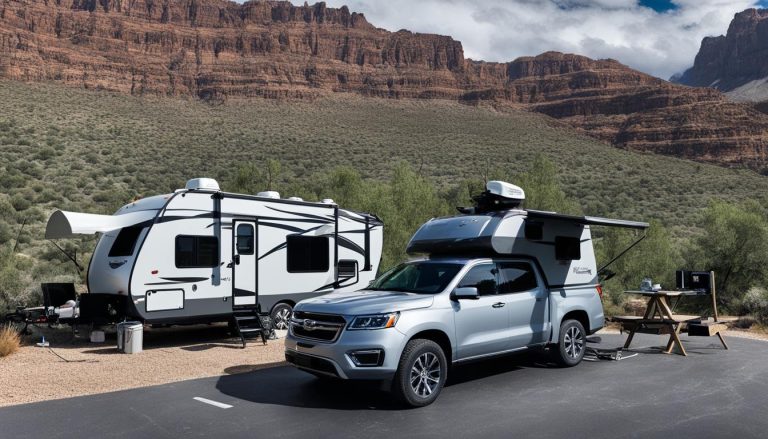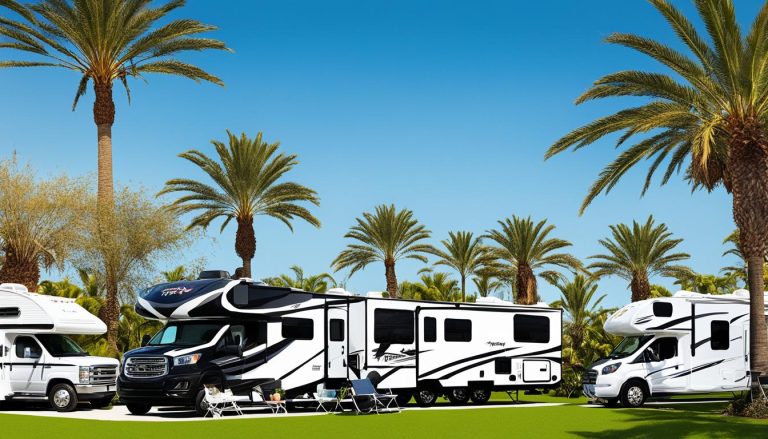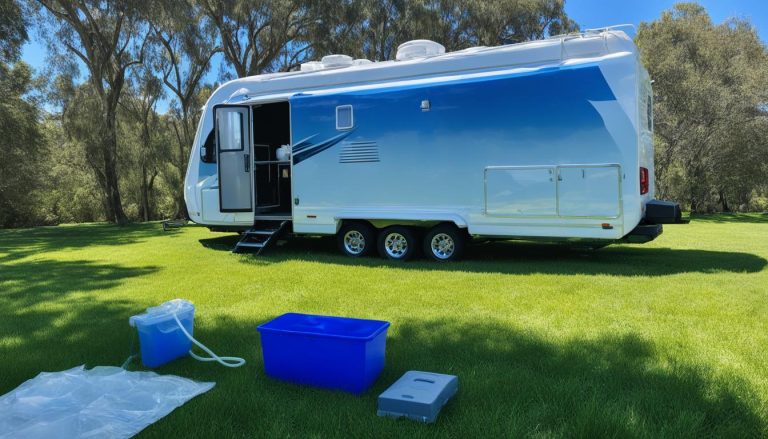Van Conversion Guide: Turn a Van into an RV
gorvlifestyle.com and its partners may earn a commission if you purchase a product through one of our links
Converting a van into an RV is a popular choice for those seeking the freedom and flexibility of van life. Whether you dream of exploring the open road or desire a compact yet comfortable living space, converting a van allows you to create your own custom home on wheels. In this comprehensive guide, we will provide you with all the information you need to successfully convert a van into an RV.
Key Takeaways:
- Converting a van into an RV offers the freedom and flexibility of van life.
- A successful van conversion requires careful planning, budgeting, and attention to detail.
- Take advantage of online resources, tutorials, and forums for inspiration and guidance during the conversion process.
- Choose the right van based on factors such as body condition, mileage, and available space for customization.
- Create a detailed layout and budget to ensure an organized and efficient conversion.
Important Tips for Van Conversion
Before diving into the van conversion process, it’s important to keep a few key tips in mind.
- Be prepared for the time and effort: Van conversion requires a significant amount of time and effort. It can quickly become a full-time project, so make sure you have the dedication and availability to see it through.
- Take advantage of online resources: There is a wealth of information available online to aid in your van conversion journey. YouTube tutorials and online forums are great sources for learning new skills and gathering inspiration for your project. Use these resources to expand your knowledge and make informed decisions.
- Consider seeking professional help: While DIY van conversions are popular, it’s essential to recognize your limitations. Reach out to professionals for tasks such as electrical and gas installation to ensure safety and compliance with regulations. Prioritizing safety is crucial for a successful conversion.
- Plan thoroughly: Detailed planning is key to a smooth conversion process. Create a layout that maximizes space utilization and meets your specific needs. Additionally, establish a budget to keep your project on track and prevent unexpected expenses.
By following these important tips, you’ll be well-prepared to embark on your van conversion journey and create the RV of your dreams.
Setting a Budget for Your Van Conversion
Setting a budget is a crucial step in your van conversion project. Knowing how much you’re willing to spend will help you make informed decisions and ensure that your conversion stays on track. The cost of converting a van into an RV can vary depending on several factors, including the quality of materials, professional services required, and the level of comfort you desire. To give you an idea, the average van conversion cost is around £10,000, excluding the initial cost of the van itself.
However, it’s important to note that you can complete a DIY van conversion on a smaller budget by focusing on essential features and opting for second-hand products. This approach allows you to save money without compromising the functionality and aesthetics of your RV. Keep in mind that your individual preferences and desired level of customization may also influence the overall cost.
Factors Affecting Van Conversion Costs:
- The quality of materials and finishes you choose
- The complexity of the project
- The need for professional services, such as electrical or plumbing
- The level of comfort and amenities you want to include
- Your ability to source cost-effective materials and equipment
By carefully considering these factors and planning your budget accordingly, you can achieve a successful van conversion that fits your needs and financial capabilities.
Finding the Right Van for Your Conversion
Choosing the right van for your conversion is crucial to the success of your project. Popular options for van conversions include the Peugeot Boxer, Fiat Ducato, Citroen Relay, Mercedes Sprinter, Ford Transit, and Volkswagen Transporter. These vans provide a good balance between size, reliability, and customization options.
When selecting a van, there are several factors to consider. First, assess the body condition of the van, ensuring there is minimal rust or damage. Next, check the mileage and service history to gauge the van’s overall health and potential repair costs. Finally, evaluate the available space for customization, making sure it aligns with your plans for the conversion.
To find the perfect van for your conversion, there are various resources you can explore. Online platforms such as Autotrader, Gumtree, and Facebook Marketplace offer a wide selection of used vans, allowing you to compare prices, features, and locations. Additionally, consider reaching out to local dealerships and spreading the word among friends and family who may know of vans for sale.
Van Comparison:
| Van Model | Price Range | Available Space | Reliability | Customization Options |
|---|---|---|---|---|
| Peugeot Boxer | $15,000 – $30,000 | Spacious interior with high roof options | Reliable engine with good fuel efficiency | Wide range of aftermarket conversion components |
| Fiat Ducato | $10,000 – $25,000 | Flexible layout options with various wheelbase lengths | Durable build and widely available spare parts | Popular choice for professional conversions |
| Citroen Relay | $12,000 – $28,000 | Comfortable cabin design with good headroom | Smooth ride quality and agile handling | Customization options for both recreational and commercial conversions |
| Mercedes Sprinter | $25,000 – $50,000 | Luxurious interior with ample cargo space | Outstanding build quality and advanced safety features | Wide range of conversion options including high-end motorhomes |
| Ford Transit | $20,000 – $35,000 | Flexible layout options with multiple roof heights | Reliable performance and good fuel economy | Popular choice for DIY conversions and camper van rentals |
| Volkswagen Transporter | $15,000 – $35,000 | Compact and maneuverable with good cabin comfort | Strong resale value and long-term reliability | Wide range of conversion options and accessories available |
By carefully considering these factors and exploring the various van options, you’ll be well on your way to finding the perfect van for your conversion. Remember to prioritize your needs and preferences to create a personalized and enjoyable RV experience.
Planning Your Van Conversion
Planning is key to a successful van conversion. Before you begin, take the time to envision how you want to use your RV and consider the features that are essential for your lifestyle. This will serve as a foundation for the rest of your conversion process.
Start by thinking about the number of people who will be traveling in the van and their specific needs. Will you need additional sleeping areas or storage space? Will you require specific amenities such as a kitchenette or a bathroom?
Sketch out a layout that includes all the necessary areas, such as sleeping, cooking, and living spaces. Ensure that your design makes efficient use of the available space. Taking accurate measurements of your van is crucial to ensure everything fits as planned.
Create a detailed plan that includes all the components and materials you’ll need for your conversion. This will help you stay organized and guide you through each step of the process.
Gather Inspiration and Ideas
While planning, it’s a great idea to gather inspiration from other van conversions. Look for online resources, such as van conversion blogs, YouTube tutorials, and social media groups, to see what others have done. This can help you generate ideas and find creative solutions for your own conversion.
“Planning is bringing the future into the present so that you can do something about it now.” – Alan Lakein
Consider Your Budget
During the planning phase, it’s important to consider your budget. Think about how much you are willing to spend on your van conversion and allocate funds for different aspects, such as materials, tools, and professional services.
By setting a realistic budget from the start, you can make informed decisions about where to invest and where to save. Keep in mind that a DIY van to RV conversion can be more cost-effective than hiring professionals for every step, but it may require more time and effort on your part.
| Component | Estimated Cost |
|---|---|
| Insulation and Soundproofing | $300 – $500 |
| Electrical System | $500 – $1,000 |
| Plumbing System | $200 – $400 |
| Bed and Sleeping Area | $200 – $600 |
| Kitchenette | $500 – $1,000 |
| Bathroom | $200 – $500 |
In addition to these costs, don’t forget to budget for any additional features or customization you desire, such as solar power systems or custom cabinetry.
With careful planning and a realistic budget in place, you’ll be well-prepared to start your van conversion journey. The next step is to gather the necessary materials and begin building the components of your RV.
Building the Components of Your RV
Building the components of your RV is an exciting part of the conversion process. It’s where you get to bring your vision to life and create a space that’s uniquely yours. Here are some essential steps to consider:
Flooring and Walls
Start by constructing the flooring and walls of your RV. Use durable materials that are resistant to moisture and provide proper insulation. This will help keep your RV comfortable and protect it from the elements.
Electrical and Plumbing Systems
Next, it’s time to install the necessary electrical and plumbing systems. This includes wiring for lights, outlets, and appliances, as well as plumbing for sinks, showers, and toilets. Follow safety guidelines and regulations to ensure everything is installed correctly and functions properly.
Custom Furniture
Build custom furniture to maximize space utilization in your RV. This can include beds, seating areas, and storage units. Consider using lightweight materials to keep the overall weight of your RV down without compromising durability and functionality.
Attention to Detail
As you build the components of your RV, pay attention to detail. Every measurement and joint should be precise to ensure a high-quality and functional end result. Take your time and don’t rush the process. Remember, this is your home on wheels, and you want it to be beautiful and functional.
Remember, building the components of your RV is just one part of the conversion process. You also need to make your RV livable and functional. Check out the next section to learn more about this exciting step.
| Benefit | Tip |
|---|---|
| Create a personalized space | Build custom furniture |
| Comfort and efficiency | Properly insulate flooring and walls |
| Functionality | Install electrical and plumbing systems |
| Attention to detail | Precise measurements and construction |

Making Your RV Liveable and Functional
After completing the construction of the main components of your RV, it’s time to focus on making it liveable and functional. Transform your van into a comfortable and convenient home away from home by incorporating essential amenities and optimizing storage space.
One crucial area to consider is the kitchenette. Install a sink with a faucet, a stove or cooktop, and a refrigerator to ensure you have all the necessary appliances for preparing meals during your travels. A compact kitchenette will provide you with the convenience of cooking your favorite dishes on the road.
A comfortable sleeping area is another vital aspect of a van to RV conversion. Design a bed that suits your preferences and space constraints. You may opt for a permanent fixed bed or a convertible seating arrangement that can be transformed into a bed at night. The key is to prioritize comfort to ensure a restful sleep during your adventures.
Bathrooms are often overlooked in van conversions but can greatly enhance the overall livability of your RV. Depending on your space and budget, you can include a portable toilet or a built-in bathroom area with a toilet and shower. These amenities will provide you with the convenience of having a private restroom wherever you go.
Comfort is essential when traveling in your RV, regardless of the season. Consider adding heating and cooling systems to regulate the temperature inside your vehicle. This will enable you to have a cozy and comfortable environment, no matter the weather outside.
Storage is a critical aspect of any van to RV conversion. Optimize your available space by incorporating cabinets, drawers, and overhead compartments. These storage solutions will allow you to keep your belongings organized and easily accessible. Think creatively to utilize every nook and cranny efficiently.
Examples of Essential RV Amenities
| Amenities | Description |
|---|---|
| Kitchenette | Includes a sink, stove or cooktop, and refrigerator for meal preparation |
| Sleeping Area | Comfortable bed or convertible seating arrangement for a good night’s sleep |
| Bathroom | Portable toilet or built-in bathroom with toilet and shower |
| Heating and Cooling Systems | Regulate temperature for year-round comfort |
| Storage Solutions | Cabinets, drawers, and overhead compartments for organized storage |
By carefully considering these elements and making smart design decisions, you can create a livable and functional RV that caters to your specific needs and enhances your travel experiences.

Stocking Up on Campervan Essentials
Now that your van conversion is complete, it’s time to prepare for your van life adventures by stocking up on campervan essentials. Whether you’re planning a cross-country road trip or a weekend getaway, having the right supplies will make your journey more comfortable and enjoyable.
First and foremost, invest in high-quality camping gear that suits your travel needs and destination. This includes a sturdy tent, sleeping bags, camping chairs, and a portable grill. Opt for compact and multipurpose items to maximize storage space in your camper van. Look for utensils, plates, and cookware that can serve multiple functions to minimize clutter.
When it comes to bedding, prioritize comfort by choosing bedding sets and pillows that provide a good night’s sleep. Consider opting for space-saving bedding options such as sleeping bags that can be easily rolled up during the day. Don’t forget to pack extra blankets and pillows for those chilly nights on the road.
In addition to camping gear and bedding, be sure to stock up on toiletries, including travel-sized shampoo, conditioner, toothpaste, and toilet paper. Remember to include safety equipment such as fire extinguishers, carbon monoxide and smoke detectors, and a comprehensive first aid kit to ensure your well-being during your van life adventures.
FAQ
What are some important tips for van conversion?
Be prepared for the time and effort required, utilize online resources for learning and inspiration, consider professional help for certain tasks, and thoroughly plan your conversion with a detailed layout and budget.
How much does it cost to convert a van into an RV?
The cost of a van conversion can vary, but on average it can be around £10,000, excluding the cost of the van. However, it is possible to complete a conversion on a smaller budget by opting for second-hand products and focusing on essential features.
What should I consider when choosing a van for conversion?
Factors to consider include the body condition, mileage, service history, and available space for customization. Popular options for van conversions include the Peugeot Boxer, Fiat Ducato, Citroen Relay, Mercedes Sprinter, Ford Transit, and Volkswagen Transporter.
How should I plan my van conversion?
Envision how you want to use your RV, consider factors such as the number of people traveling and desired amenities, create a detailed layout and plan that includes all necessary components and materials, and take accurate measurements of the van.
What are the main components I need to build in my RV conversion?
Start with constructing the flooring and walls, then install necessary electrical and plumbing systems, build custom furniture such as beds and storage units, and consider using lightweight materials to minimize the weight of the RV.
How can I make my RV livable and functional?
Install essential amenities such as a kitchenette, sleeping area, and bathroom with a toilet and shower. Consider adding heating and cooling systems, optimizing storage space, and prioritizing functionality and convenience in your design decisions.
What should I stock up on for my campervan?
Stock up on camping gear, kitchen supplies, bedding, toiletries, and safety equipment. Invest in quality camping equipment, purchase compact and multi-functional items to maximize storage space, and ensure you have essential safety equipment for your adventures.






